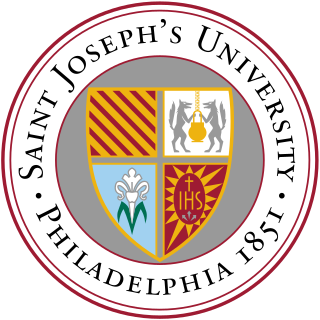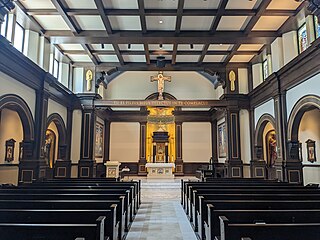
Cass Gilbert was an American architect. An early proponent of skyscrapers, his works include the Woolworth Building, the United States Supreme Court building, the state capitols of Minnesota, Arkansas, and West Virginia, the Detroit Public Library, the Saint Louis Art Museum and Public Library. His public buildings in the Beaux Arts style reflect the optimistic American sense that the nation was heir to Greek democracy, Roman law and Renaissance humanism. Gilbert's achievements were recognized in his lifetime; he served as president of the American Institute of Architects in 1908–09.

Loras College is a private Catholic college in Dubuque, Iowa, United States. It has an enrollment of approximately 1,600 students and is the oldest post-secondary institution in the state of Iowa. The school offers both undergraduate and graduate degree programs. It is one of four four-year post-secondary institutions in the City of Dubuque, one of four Catholic colleges in the Archdiocese of Dubuque, and one of six Catholic colleges in the state of Iowa. The campus was listed on the National Register of Historic Places as the Loras College Historic District in 2020.

Saint Joseph's University is a private Jesuit university in Philadelphia, Lower Merion Township, Pennsylvania, and Lancaster, Pennsylvania. The university was founded by the Society of Jesus in 1851 as Saint Joseph's College. Saint Joseph's is the seventh oldest Jesuit university in the United States and the sixth largest university in Philadelphia. It is named after Saint Joseph. It merged in 2022 with the University of the Sciences. In 2023, Saint Joseph's University announced it would acquire Pennsylvania College of Health Sciences. This will expand Saint Joseph's University by adding a campus in Lancaster, Pennsylvania and expanding the size of the student body especially with students studying nursing and health.

St. Lawrence University is a private liberal arts college in the village of Canton in St. Lawrence County, New York. It has roughly 2,100 undergraduate and 100 graduate students.

The University of St. Thomas is a private Catholic research university with campuses in St. Paul and Minneapolis, Minnesota. Founded in 1885 as a Catholic seminary, it is named after Thomas Aquinas, the medieval Catholic theologian and philosopher who is the patron saint of students. As of fall 2021, St. Thomas enrolled 9,347 students, making it Minnesota's largest private, nonprofit university.

The University of Exeter offers approximately 6,500 purpose-built student bed spaces for its students. The majority of its residences are located on campus, although 30% of self-catered accommodations are located off-campus.

The Archdiocese of Saint Paul and Minneapolis is a Latin Church ecclesiastical jurisdiction or diocese of the Catholic Church in the United States. It is led by an archbishop who administers the archdiocese from the cities of Saint Paul and Minneapolis. The archbishop has both a cathedral and co-cathedral: the mother church – the Cathedral of Saint Paul in Saint Paul, and the co-cathedral, the Basilica of Saint Mary in Minneapolis.

The University of Nebraska at Kearney (UNK) is a campus of the public University of Nebraska system and located in Kearney, Nebraska. It was founded in 1905 as the Nebraska State Normal School at Kearney.

Joseph Crétin was an American Catholic prelate who was the first Roman Catholic Bishop of Saint Paul, Minnesota. Cretin Avenue in St. Paul, Cretin-Derham Hall High School, and Cretin Hall at the University of St. Thomas are named for him.

Housing at the University of California, Berkeley, includes student housing facilities run by the office of Residential and Student Service Programs (RSSP). Housing is also offered by off-campus entities such as fraternities and sororities and the Berkeley Student Cooperative (BSC).

Cretin-Derham Hall High School (CDH) is a private, co-educational Catholic high school in Saint Paul, Minnesota operated by the Archdiocese of Saint Paul and Minneapolis. It is co-sponsored by the Brothers of the Christian Schools and the Sisters of St. Joseph of Carondelet.

St. Edward's Hall is one of the 32 Residence Halls on the campus of the University of Notre Dame and one of sixteen male dormitories. Saint Edward's Hall is located directly east of the Main Administration Building and is directly west of Zahm Hall and houses 162 undergraduate students. The dorm community and culture are not as old as Sorin College (1888) as it was established as an undergraduate residence hall 30 years later. However the building itself was built in 1882 to house the minims, Notre Dame's boarding school program. When such program was discontinued in 1929, the building was converted to an undergraduate residence hall, which it has been ever since. Together with other historical structures of the university, it is on the National Register of Historic Places. The coat of arms is the Cross of Saint Edward the Confessor on a green background.

Livingston Campus, originally named Kilmer Area by Rutgers University in 1965, and later known as Kilmer Campus, is one of the five sub-campuses of Rutgers University–New Brunswick. The campus was originally built to house Livingston College. The majority of its land is the Rutgers Ecological Preserve. Most of the campus is within the boundaries of Piscataway, but parts extend into Highland Park and Edison.

The Danforth Campus is the main campus at Washington University in St. Louis. Formerly known as the Hilltop Campus, it was officially dedicated as the Danforth Campus on September 17, 2006, in honor of William H. Danforth, the 13th chancellor of the university, the Danforth family and the Danforth Foundation. Distinguished by its collegiate gothic architecture, the 169-acre (0.68 km2) campus lies at the western boundary of Forest Park, partially in the City of St. Louis. Most of the campus is in a small enclave of unincorporated St. Louis County, while all the campus area south of Forsyth Boulevard is in suburban Clayton. Immediately to the north across Forest Park Parkway is University City.

The Saint Paul Seminary (SPS) is a Catholic major seminary in St. Paul, Minnesota. A part of the Archdiocese of Saint Paul and Minneapolis, SPS prepares men to enter the priesthood and permanent diaconate, and educates lay men and women on Catholic theology.

Saint John Vianney College Seminary (SJV) is the largest Catholic college seminary in the United States, located on the campus of the University of St. Thomas in St. Paul, Minnesota, representing 18 dioceses throughout the nation with more than 100 men in formation annually. Established in 1968, SJV nurtures the seeds of a priestly vocation, preparing young men for major seminary through integral formation and discipleship in Christian character, a traditional Catholic program of spiritual growth, and a formative liberal arts education. Over 750 alumni are serving as ordained priests today.
The Minnesota State University campus in Mankato, Minnesota currently contains 32 buildings spread over 354 acres (143 ha) and 77 acres (31 ha) of protected ravine. The campus includes on-and-off campus residence communities, academic buildings, libraries, astronomy observatories, center for renewable energy, recreation centers, student center, administration centers, athletics fields, and dining areas. There are 31 dedicated and memorial sites around campus. Downtown, the Mayo Clinic Health System Event Center is used for their men and women hockey teams. Eight miles from campus, the Mankato Regional Airport is used to train Aviation students.

Lee and Penny Anderson Arena is an indoor arena under construction on the campus of the University of St. Thomas in Saint Paul, Minnesota. The facility is planned to be the home arena of the St. Thomas basketball and hockey teams.

The second Cathedral of Saint Paul was a building that served as the Catholic cathedral of the Diocese of Saint Paul in Minnesota from 1851 to 1858. Almost immediately recognized as being insufficient, planning for a third cathedral began shortly after construction was completed. Until its demolition in 1889, the three-story building also served as the Cathedral School, predecessor of Cretin High School.


















